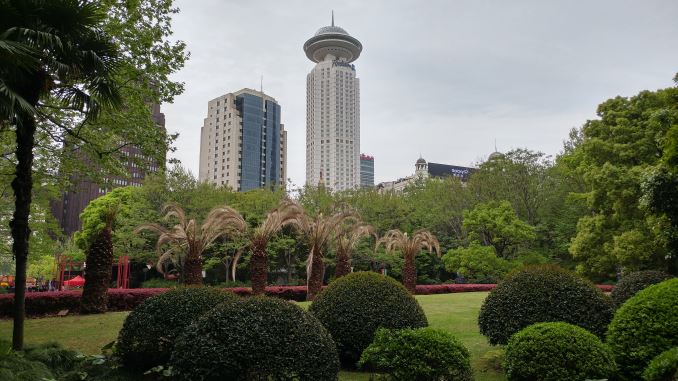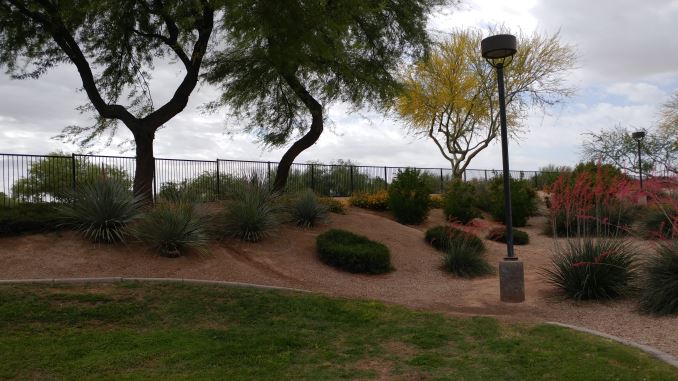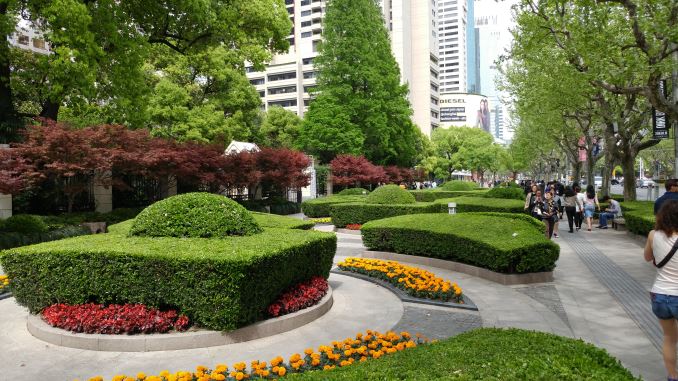The LG G5 Review
by Matt Humrick on May 26, 2016 8:00 AM EST- Posted in
- Smartphones
- Snapdragon
- Qualcomm
- LG
- Mobile
- Snapdragon 820
- LG G5
Camera Still Image Performance
The G5 has an admirable list of camera hardware; however, it takes more than an impressive spec sheet to take good photos. The camera’s post-processing routines—noise reduction, edge sharpening, lens corrections, etc.—also have a significant impact on image quality.
To see how the G5’s cameras perform, we’ll be comparing photos taken in a variety of lighting conditions to those of its peers. The G5 uses the same hardware as the G4, so we do not expect to see a big difference between the two LG devices. All of the other phones use 12 MP sensors with larger pixels—actually two 12 MP sensors for Huawei’s P9, one color and one black and white—except for the Moto X Pure Edition, which uses a higher resolution 21 MP sensor with the standard 1.12μm pixels. The G4 and G5 use a native 16:9 aspect ratio while the other phones use a 4:3 aspect ratio. All of the images shown below were taken using the stock camera app's Auto mode unless noted.
| LG G5 Wide-Angle Camera Examples: Day, Night |
Before we compare the G5 to other devices, let’s look at the difference between its dual rear cameras. The two examples above show just how effective the G5’s wide-angle camera is at increasing field of view. They also show how the wide-angle camera’s shorter focal length makes objects appear much smaller. In most cases, white balance and exposure are about the same for both cameras so, apart from the focal length effects, images look comparable (LG’s special long exposure mode kicked in for the wide-angle night shot).
One of the G4’s problems is its tendency to set the white balance too warm, which the purplish sky and red-tinted bricks and rocks clearly show in our daylight images. The G5 avoids this problem, correctly setting the white balance in both images; it appears LG made some tweaks to the G5’s software. The only phones to get white balance and exposure correct in both sets of images are the Galaxy S7 edge and G5, although all of the phones do pretty well in these conditions.
The Moto X Pure Edition struggles with dynamic range, clipping the sky in the image with the flowers, and its strong noise reduction processing smoothes away fine detail, like on the fountain wall and the bricks in the road. The G4 also employs heavy noise reduction, but the G5’s algorithm is a bit more mild, producing more visible noise grain but sharper detail. When it comes to noise in bright outdoor conditions, the G5 sits about in the middle of this pack the G5 sits about mid pack, with the iPhone 6s Plus, Huawei P9, and Galaxy S7 edge all performing just a little better.
In the fountain scene, the G5’s wide-angle camera captures considerably more noise than the primary camera. Its image also contains far less detail than the primary camera’s image, partially because it has half the resolution (8 MP vs 16 MP) and partially because there are fewer pixels per feature for the smaller objects.
This next series of images were taken on a cloudy day, which is a more challenging condition because there’s less light to work with and a different color temperature to adjust for. Even with less light all of the phones were able to use their minimum ISO setting to help reduce read noise. In both scenes, the Galaxy S7 edge takes the brightest picture despite using the fastest shutter speed. The G5’s images are a little darker than the G4’s because it favors a shorter exposure, but it still produces brighter images than the Moto X and Nexus 6P. While the P9 produces acceptably bright images, it struggles to do so, with a shutter speed that is about twice as slow on average than the rest of the group. It does have a relatively small aperture, but with its second black-and-white camera sensor dedicated to gathering luminance data, we were expecting it to perform better under these conditions.
Surprisingly, all of the phones do pretty well setting white balance after compensating for the differences in brightness. The G4 and G5 show the dirt as being too red, but the clouds and grass still look fine.
In both of these images, the G5 and iPhone 6s Plus show some purple fringing caused by chromatic aberration on the edges of the fence, trees, and yucca plant on the left and right edges of the frame. It’s odd that we do not see this in the G4’s images because it uses the same lens system. Perhaps we’re seeing some manufacturing variance. Also, while not detrimental to image quality, the Galaxy S7 edge, and the P9 to a lesser extent, show some white haloing around dark objects indicative of edge sharpening in post-processing that is not present in the G5’s images.
HDR effectiveness varies significantly between the phones in this roundup. At one end of the scale sits the iPhone 6s Plus, which improves the overexposed sky but does nothing to brighten the darker areas (it actually makes the grass darker), followed closely by the Nexus 6P, which also does nothing for the areas in shadow. The G4 and G5 are at the other end of the scale, displaying more dramatic results. The clipped sky is nearly eliminated with clearly visible white clouds against a proper blue sky. Areas in shadow are considerably brighter, bringing out detail in the bushes and rocks, and the grass and wall in the background are also lighter without looking unnatural.
Both of the G5’s cameras continue to show purple fringing on the left and right edges of the image, particularly around the palm tree on the right that represents a worst-case scenario, but the G5’s HDR mode at least manages to avoid the loss of detail and color saturation that can occur with HDR processing. In contrast, the Galaxy S7 edge’s HDR mode washes away detail, making the grass look smoother, both in the foreground and background, and the trees and buildings in the background look blurry. While HDR performance can vary from one scene to the next, the G5 is the clear winner in this HDR shootout.
The Galaxy S7 does outperform the G5 in HDR processing speed, however. Where the Galaxy S7 takes HDR photos about as quickly as it does normal photos, there’s about a one-second delay when capturing an HDR image with the G5, which is about three to four times longer than a regular photo. The Galaxy S7 also provides a live preview of what the final HDR image will look like in the viewfinder, but the G5 does not.
The first series of images were taken about one hour before sunset in a shaded location. None of the phones get white balance perfect, but the Galaxy S7 edge and Moto X Pure Edition are the furthest from ideal, their images showing an obvious cool blue tint. The Nexus 6P and Huawei P9 lead the group, and the remaining phones all fall pretty close to the correct white balance setting.
The second series of images were taken after sunset but before darkness fell. The iPhone 6s Plus makes good use of OIS to increase exposure by 2-4x relative to the other phones and allowing it to keep ISO at 64, the lowest value of the group, although its image still comes out a little dark. The P9’s image is also a little dark, which again is surprising to see. It’s this very scenario where its dual-camera setup should give it the edge in luminance; however, with small aperture lenses and no OIS it must take a shorter exposure and drive ISO to 800, the highest value of the group. The G4’s image is bright but unnaturally so. It’s the G5 that actually captures the best exposure.
The bright light on the side of the building proves difficult to handle for the G5, Nexus 6P, and Galaxy S7, forcing their white balance to skew too yellow. The G4 and P9 perform better with nicer looking colors.
Once again the G5’s noise reduction is less extreme than the G4’s, which preserves detail at the expense of more noise grain. The G5 does avoid the weird yellow splotches on the building that are present in the G4’s image, a byproduct of its noise reduction processing. When it comes to visible noise, the G5 sits in the middle of this pack.
This first series of images were taken against a white background using LED studio lights with a color temperature of about 5400 K, which the cameras should handle easily. Indeed, they all produce acceptable images, although, only the Moto X Pure Edition gets both the white balance and exposure correct. The G5 also gets the white balance correct, an improvement over the G4 which is a bit too cool, but underexposes the image slightly like most of the other phones.
Unfortunately, the G5’s image is marred by noise. It’s easily the worst of the group, with noise visible even when zoomed out on the green portion of the box. In comparison, the Moto X shows almost no noise and no loss in sharpness. It’s also a bit surprising to see the Galaxy S7 edge and iPhone 6s Plus struggle with noise in this scenario.
The iPhone 6s Plus handles the warm, yellow light from an incandescent bulb the best in the second set of images, capturing a bright image with the most realistic color. The Moto X manages to remove the yellow tint from the light, rendering a nearly neutral background. This approach desaturates colors, particularly yellow, however. The G5 goes in the other direction, creating an image with an obvious yellow cast. It does well with exposure, but once again shows more noise than the other phones.
A smartphone’s z-height limitation makes designing a camera free of optical aberrations a unique engineering challenge, and the current trend towards shorter focal lengths and larger apertures puts extra pressure on the lens system design and lens correction software. We’ve seen some of the cameras in this roundup, including the G5’s, exhibit one type of optical issue: lateral chromatic aberration (purple fringing). Two other common optics problems are distortion and vignetting (dark shading in the image corners). Fortunately, none of the cameras suffer from barrel distortion (the G5’s wide-angle camera shows severe barrel distortion, but this is expected for a fisheye lens). The Galaxy S7 edge shows no vignetting, while the Nexus 6P suffers from this issue to a mild degree. All of the other phones, including both of the G5’s cameras, show negligible vignetting.
| LG G5 Additional Sample Images |
While LG’s camera app comes up short in some of its post-processing routines, adversely affecting photo quality, it at least takes photos quickly. The app itself launches in about 1.0-1.5 seconds, equaling the best flagships. Like the Galaxy S6 and S7, the G5 preloads the camera app when the phone boots and leaves it running in the background. It keeps the app resident in RAM at all times, ignoring attempts to force close it, which helps minimize the launch time. The time it takes to capture images varies depending on lighting conditions but generally hovers between 0.25-1.0 second.
Overall, the G5 takes pretty good photos but quality varies depending on the lighting condition. In bright daylight, the G5 equals the Galaxy S7 edge, producing excellent looking photos. When there’s less light available, like on cloudy days or when moving indoors, the G5 starts to struggle. It still does pretty well setting white balance and exposure, although the iPhone 6s Plus consistently does better. Image noise, however, is a serious problem for the G5. Its images show significantly more noise grain than other flagship devices, degrading image quality. LG definitely has some work to do on its noise reduction algorithm because it either creates yellow spotty artifacts, like with the G4, or it does essentially nothing, like with the G5.
Video Quality
LG’s decision to make video recording a differentiating feature for its flagship V10 leaves the G Series feeling a bit neglected. The G5’s video experience does not add much to what the G4 offers, and the G4’s video features were essentially the same as the G3’s.
This lack of progress over the past two years handicaps the G5 relative to current flagship phones and leaves it with a feature set comparable to mid-range offerings. It still lacks a 1080p60 mode, which is essential for capturing video with smooth motion, and its slow-motion video is stuck at 120fps. The G5 also does not support HDR video.
The only new feature the G5 has that the G4 does not is electronic image stabilization (EIS). The G5 also increases the bit rate for 4K video to 48 Mb/s, up from the G4’s relatively low 30 Mb/s.
| Rear Camera Video Modes | |||||||
| Video Mode | Resolution | Frame Rate (fps) | Video Bit Rate (Mb/s) | Video Codec | Profile | Audio Codec | Audio Bit Rate (kb/s) |
| UHD 4K | 3840x2160 | 30 | 48 | H.264 | High | AAC (48kHz) | 156 |
| FHD 1080p | 1920x1080 | 30 | 17 | H.264 | High | AAC (48kHz) | 156 |
| HD 720p | 1280x720 | 30 | 12 | H.264 | Baseline | AAC (48kHz) | 156 |
| Slo-mo | 1280x720 | 120 | 48 | H.264 | Baseline | AAC (48kHz) | 156 |
| Front Camera Video Modes | |||||||
| Video Mode | Resolution | Frame Rate (fps) | Video Bit Rate (Mb/s) | Video Codec | Profile | Audio Codec | Audio Bit Rate (kb/s) |
| FHD 1080p | 1920x1080 | 30 | 17 | H.264 | High | AAC (48kHz) | 156 |
| HD 720p | 1280x720 | 30 | 12 | H.264 | Baseline | AAC (48kHz) | 156 |
Even though its feature set is lacking, the G5’s video quality is pretty good. It does noticeably better than the G4 at setting white balance, something the G4 struggles with, and even a little better than the Galaxy S7. The G5 struggles with noise the same as it did with still images. It’s not much worse than the Galaxy S7 in daylight, but the G5 does show some blockiness when panning across the sky or constant-color surfaces. Video shot in lower-light conditions shows considerable noise grain because there's basically no noise reduction processing. The advantage to this approach is that the G5’s video looks a bit sharper than the S7’s. What has the biggest negative impact on image quality, however, is the G5’s lack of HDR support. Bright highlights are consistently overexposed and blown out, while areas in shadow appear overly dark. The Galaxy S7’s auto HDR video mode eliminates these problems just as it does for still images. I also found that the G5 picks up a lot more wind noise than the S7 or iPhone 6s.
The G5 can use either of its rear cameras to shoot video, and will also switch between them while recording. Whether you directly toggle between the cameras or use the digital zoom method, the transition is not seamless, though. There’s around a half-second delay to make the switchover and to refocus.
The primary rear camera automatically uses OIS to remove minor vibrations from the video. This helps compensate for shaky hands, but it also introduces a wobble in the video whenever the camera changes direction that looks very unnatural. Fortunately, the G5 now includes an option to enable EIS in addition to OIS. Doing so further dampens vibrations and almost eliminates the OIS wobble. Compared to the Galaxy S7, which also combines OIS and EIS, the G5’s image stabilization works better, with fewer OIS resets (reaching the motion limit causes the video frame to jump) and less motion blur from vibrations.
The bad news is that EIS is unavailable when recording 4K video. There’s also a five-minute recording limit for 4K video and the ability to capture still images while recording 4K video is disabled. All of these limitations make the G5’s 4K recording mode feel like nothing more than a gimmick.
The G5’s slow-motion video mode is even less useful than its 4K mode. It only works with the primary rear camera and not the wide-angle or front-facing cameras. There’s also no EIS support, just like the 4K mode. The video quality is also worse than the other regular speed modes, with considerably more noise. And while the iPhone 6s manages to capture perfectly smooth slow-motion video at both 720p240 and 1080p120, the G5 creates jerky video with lots of dropped frames even at 720p120.














































92 Comments
View All Comments
osxandwindows - Thursday, May 26, 2016 - link
finally!.zeeBomb - Thursday, May 26, 2016 - link
Damn... This review surprised me! Still won't get it, but nice to have itv finally doneAlexey291 - Thursday, May 26, 2016 - link
As usual their reviews are so late that the devices of the current generation have been bought already by those who was planning to buy them.Unless it's an iPhone ofc. That shit gets a review in a week
tuxRoller - Thursday, May 26, 2016 - link
First, that's probably an exaggeration.Second, there are only a couple of iphone launches every year, at most. That's a much easier load to track compared to the swarm of android devices that dribble out over the year (with a plurality released around March, tbh).
marcolorenzo - Sunday, May 29, 2016 - link
So what? Why does it matter how many Android devices there are compared to iPhones? The OS has nothing to do with reviewing a phone, that kind of segregation makes absolutely no logical sense. Of course, during this period when several manufacturers decide to release their phones at the same time, the workload of reviewers would suddenly spike but it still doesn't excuse the delays they have during other times of the year. Let's just face facts. IPhones, like sex, sells. Of course they would double down and getting a review of the latest iPhones out the door, they get more viewers that way.tuxRoller - Sunday, May 29, 2016 - link
It matters because the person I responded to mentioned how iPhone reviews come out relatively quickly. I responded by explaining my understanding of the situation, which is that phones are, in a practical sense, categorized by their OS. Specifically with regards to apple, they are there only ones who produce ios phones, and only make, at most, a couple of releases a year. What's more, those particular phones are the most purchased of any particular phone so interest is highest in them.For Android, the sales distribution is far more diffuse, and Samsung, for one, has at least a couple major releases every year.
When you have a finite amount of man power you have to distribute it in a way that provides the most benefits.
As for their delays during other times, there were, iirc, mitigating circumstances(reviewers were sick, schoolwork, etc). If you have actual knowledge that indicates otherwise I'd be interested.
anoxy - Monday, May 30, 2016 - link
Wait, are you really that dense? You answered your own question but you're still throwing a hissyfit?More phone releases = more workload = increased delays in using (adequately) and reviewing every phone.
There are usually two iPhones, and they likely receive review units well in advance and thus have plenty of time to use them. And yes, there is a greater incentive to review an insanely popular device like the iPhone. Why does that upset you?
Ranger1065 - Friday, May 27, 2016 - link
Nicely written article, but even, "better late than never" barely applies. Anandtech takes another GIANT step, towards obsolescence...Alex J. - Friday, May 27, 2016 - link
I agree, it's pretty disappointing how more and more "late" all of their reviews are becoming... At this rate, the HTC10 review would probably come at the end of the summer.And yea, "better late than never" phrase is also losing its relevancy - most of the people whom I personally know and who were planning to "upgrade" their Android phones this year have already done so, meaning the "late" reviews like this have lost all relevance to them. But whatever - if Purch Media wants to run Anandtech into the ground - it's their choice.
DiamondsWithaZ - Monday, September 19, 2016 - link
It did haha. The HTC 10 review literally just got posted... The phone has been out for almost 6 months.